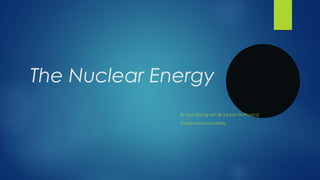
Nuclear energy
- 1. The Nuclear Energy By Soe hlaing win (4-Ya pa-16 Physics) Yadanabon University
- 2. Introduction Nuclear power was discovered over 100 years ago. Everything related to nuclear power has not been a positive invention. Right now nuclear power is being developed towards the benefit of mankind.
- 3. History of Nuclear Physics The late 20’s and early 30’s are known for discovering radioactivity and the huge steps forward in the techniques and instrumentation of nuclear physics. Scientists had to create large electric fields to be able to continue their research. 1930’s- Ernest Lawrence invented the cyclotron (=circular magnatic accelerator).
- 4. Nuclear Physics Basic History It is very difficult to date the birth of nuclear physics. The year 1932 is considered to be the birth year of nuclear physics due to the discovery of the neutron, positron, deuteron and the completion of the first particle accelerator. 1896- Henri Becquerel accidentally discovered radioactivity 1898- Marie and Pierre Curie discovered radium and polonium 1920’s- A. Eddington, R. Atkinson and F.Houtermans suggested that the Sun’s steady energy release was due to nuclear fusion reactions. 1928- G. Gamow, E. Condon and R. Gurney showed that charged particles have enough energy to penetrate a nucleus and cause its disintegration.
- 5. Nuclear Power Station in the World
- 6. Nuclear Power Today Provides almost 20% of world’s electricity (8% in USA) 69% of U.S. non-carbon electricity generation More than 100 plants in U.S. None built since the 1970s 200+ plants in the Europe Leader is France About 80% of its power from nuclear
- 7. Further Development of Nuclear Power Today nuclear physics is developing in a more peaceful direction We are starting to become more and more dependant on nuclear power. Nuclear power produces more than 25% of the total electricity made in over 15 countries There is a total of about 440 nuclear reactors around the world.
- 8. Nuclear Fission Fission is the splitting of a heavy nucleus into lighter nuclei. Does not require a lot of energy. The energy released by fission is many times greater than the energy released by a chemical reaction.
- 9. Nuclear Fusion Fusion is the fusing of light nuclei into a heavier nucleus. It requires a lot of energy to bring the protons close enough to overcome their electrostatic repulsion. The energy released by fusion is many times greater than the energy released by nuclear fission.
- 10. Nuclear Weapons (fission & Fusion weapons)
- 11. Nuclear Bomb (Atomic Bomb) Fission weapons get their energy by blasting u-235 (an isotope of uranium) together forming a chain reaction. When the u-235 is blasted the nuclei split, giving out energy
- 12. Atomic Bomb, Fat Man There is another way to form critical mass. Using shock-waves from shaped explosives the sub-critical mass is compressed. Fewer electrons are lost and the chain reaction begins.
- 13. Nuclear Weapons Policies After the end of Cold War, USA, G-7 and Russia established the Cooperative Threat Reduction Programs to 1. dismantle strategic nuclear weapons 2. strengthen the security of nuclear weapons and materials 3. employ key scientists in weapons of mass destruction (WMD) complexes. Russia and USA did not become allies. Despite the signed agreement of detargeting, each country has suspicions over other’s missiles explaining the sizes of their nuclear arsenals.
- 14. What is Nuclear disaster
- 17. Conclusion Nuclear power was discovered over 100 years ago. It has developed at a rapid speed thanks to the invention of nuclear arms. Everything related to nuclear power has not been a positive invention Now nuclear power is being developed towards the benefit of mankind.
- 18. Bibliography Frontiers. twentieth-century physics, Steve Adams, 2000, London and New York BSE (Big Soviet Encyclopedia, huge list of authors,) The Dictionary of Battles. the world's key battles from 405 BC to today, general editor David Chandler, 1987, Ebury Press, London Building the Universe, a new scientist guide. edited by Christine Sutton, 1985, Oxford http://www.hps.org/publicinformation/ate/q1662.html http://www.euronuclear.org/info/npp-ww.htm http://www.diffen.com/difference/Nuclear_Fission_vs_Nuclear_Fusion http://www.hep.man.ac.uk/babarph/babarphysics/positron.html http://science.howstuffworks.com/nuclear-bomb6.htm http://www.bbc.co.uk/history/historic_figures/rutherford_ernest.shtml http://www.huwu.org/nobel_prizes/physics/laureates/1935/chadwick-bio.html http://nobelprize.org/nobel_prizes/physics/laureates/1951/cockcroft-bio.html http://en.wikipedia.org/wiki/Ernest_Walton http://nobelprize.org/nobel_prizes/physics/laureates/1951/walton-bio.html http://www.world-nuclear.org/why/nuctoday.html http://www.world-nuclear.org/info/reactors.html